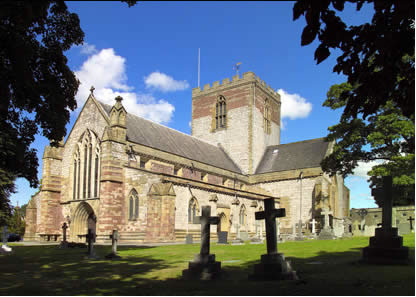St Asaph
A wee city with a population of less than 4,000, the greatest attraction here is St Asaph's Cathedral. No bigger than most village churches, it is the smallest cathedral in the UK
Early History
Llanelwy is the Welsh name for the place called St Asaph. It means the sacred religious enclosure on the banks of the River Elwy. It is impossible to give an historically accurate account of the beginnings of Christianity in the early settlement at Llanelwy. Legend and tradition are confusingly mixed and there is no archaeological evidence or written record before the twelfth century. The legend of the founding of the church and monastery between the year c.560 and c.573 is to be found in 'The life of St Kentigern' written by Jocelyn, a monk of Furness Abbey c.1180. St Kentigern was the bishop of Strathclyde; he was driven into exile and founded a monastery at Llanelwy where he remained until his return to Scotland in 573. There are no local commemorations to Kentigern. St Asaph replaced him as abbot-bishop until he died in 596.

In the eastern window of the north aisle there are pictures of St Kentigern and St Asaph illustrating two of the legends told by Jocelyn. Miraculously, St Kentigern helps to find the gold ring which the Queen has lost and it is discovered in a salmon caught by the saint. St Asaph, as a boy, was sent by St Kentigern to bring coals that he might warm himself. Having nothing else in which to carry the burning coals he uses his cloak but neither his own flesh nor the cloak were burnt.
St Asaph was a local saint whose name is found in the neighbouring Llanasa(Asa's Church), Pantasa (Asa's Hollow), Ffynnon Asa (Asa's Well), Onen Asa (Asa's Ash-tree); these place names suggest a strong religious settlement. Asaph's name and reputation was much advanced by the creation of a new territorial episcopal see at Llanelwy in the twelfth century. From about 1073 Rhuddlan was in the possession of the Normans and it was expedient that they protected their interests and those of the Province of Canterbury, Theobald, consecrated Gilbert as its first bishop.
The next bishop, Geoffrey of Monmouth, was styled as bishop of the Church of St Asaph in 1152. In spite of the existing religious settlement at Llanelwy scholars believe that a new cathedral was built on a new site some distance away from the older parish church. By the year 1281 the relics of St Asaph had been removed from Llanasa and were enshrined in the newly-built cathedral. Gerald of Wales came here in 1188 with Archbishop Baldwin who said Mass. Perhaps in contempt of Bishop Adam, whom Gerald the Archdeacon had excommunicated at Kerry in 1176, he wrote of 'the poverty-stricken little Cathedral of St Asaph'.
The Thirteenth Century
The site chosen at Llanelwy was in a perilous position being on the 'war path' of the Welsh Princes and English Kings. How much destruction the new building suffered in the thirteenth century is not known. Some of the early building work begun by bishop Hugh (1235-40) has survived in the gables and chamfered buttresses on the west front, the south west corner buttresses, and the walls of the early English choir.
A significant event was the appointment of Anian II as bishop (1268-93); his effigy is in the south aisle. As Dominican Prior of Rhuddlan he was known as 'the black friar of Nannau and as the best and stoutest upholder ever seen of the rights of his bishopric'. Anian withstood the enmity of Llwelyn ap Gruffydd, the last Prince of Wales, and sought the protection of King Edward I. The King was in favour of the removal of the Cathedral church from Llanelwy to Rhuddlan and promised in 1281 an ample site and a thousand marcs towards building the new church. It was said that at Llanelwy the canons 'had little protection, and where, because of its location, even on great festival days the canons had to celebrate without a congregation'.
Anian was in favour but the project was abandoned when on Palm Sunday 1282 the Welsh revolted and sacked the castle at Hawarden. Later, in June, there was the accidental burning of the cathedral by English soldiery whom Anian promptly excommunicated, having previously refused to do to the Welsh rebels. Out of favour with Edward I the Bishop fled from St Asaph nevermore to enjoy the King's confidence. Archbishop Pecham intervened and insisted that the diocesan see remain at Llanelwy and that the Cathedral church be rebuilt. As a sign of Anian's fall from Edward's favour the small sum of one hundred pounds was paid as compensation for damage to the Dean and Chapter.
For more Information visit http://www.stasaphcathedral.org.uk






